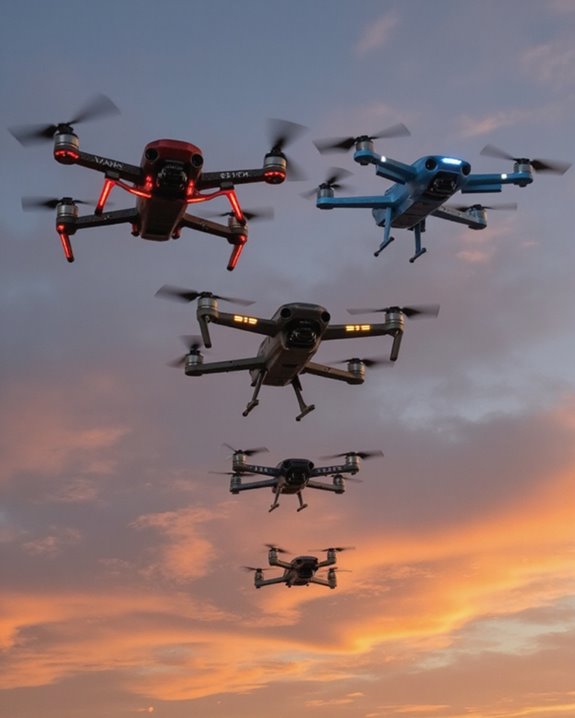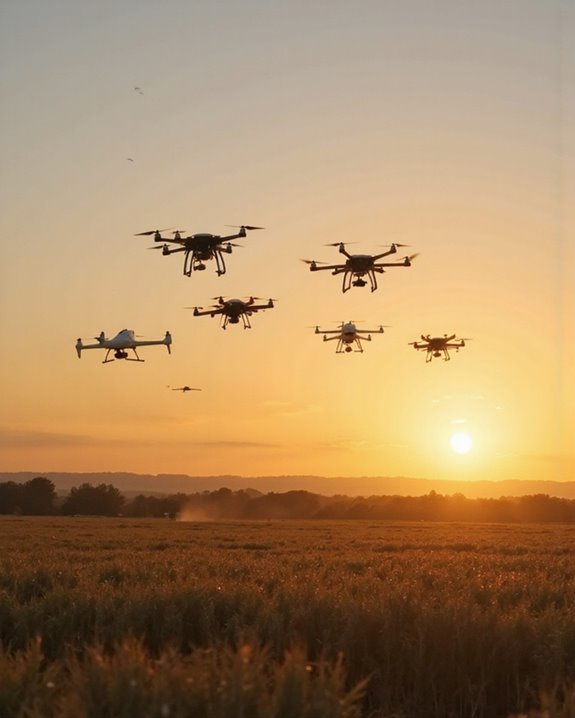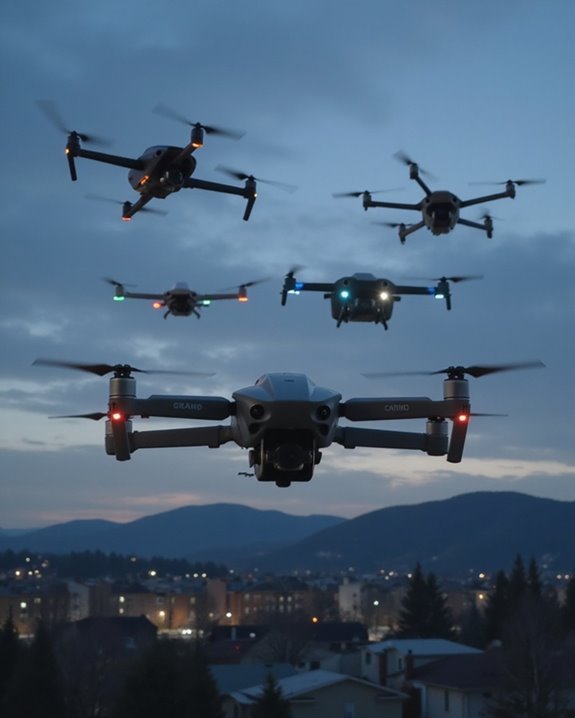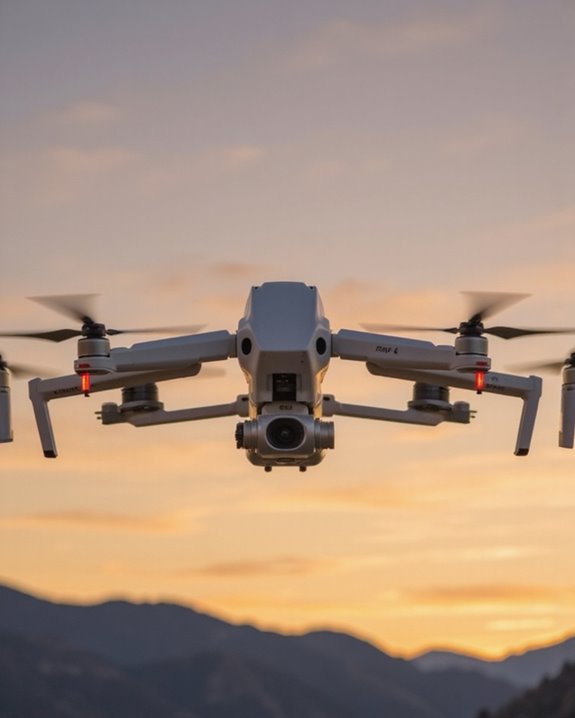Looking for the world’s fastest drones in 2025? The DJI Mini 3 leads the pack at an impressive 21.6 kph, while the Potensic ATOM SE hits speeds up to 16m/s in Sport Mode! The N11 PRO, Mini FPV, and Potensic ATOM 2 round out the top five with their remarkable speed capabilities. These lightning-fast drones combine raw power with advanced features like 4K cameras and extended flight times. Let’s explore what makes each of these speed demons truly soar!
Key Takeaways
- The DJI Mini 3 reaches speeds of 21.6 kph while maintaining stability through its 3-axis gimbal system.
- Potensic ATOM SE achieves impressive speeds up to 16 meters per second (57.6 kph) in Sport Mode.
- Racing drones typically achieve higher speeds than consumer camera drones due to their lightweight, aerodynamic design.
- Wind resistance ratings significantly impact a drone’s actual achievable top speed in real-world conditions.
- Professional racing drones can exceed 120 mph while camera-focused consumer drones usually max out around 45-70 mph.
DJI Mini 3 Camera Drone with Remote Controller
- No Registration Needed - Under 249 g, FAA Registration, and Remote ID are not required if you fly for recreational purposes. Visit the FAA's official website for...
- 4K UHD Stunning Imagery- Film in 4K HDR Video for crystal clear aerial shots. With Dual Native ISO Fusion, Mini 3 enables the capture of details in highlights and...
- Striking Vertical Videos are Ready to Share - With True Vertical Shooting, you can easily capture tall landmarks like skyscrapers and waterfalls. And after capturing,...
For drone enthusiasts who want professional-quality aerial photography without FAA registration hassles, the DJI Mini 3 Camera Drone hits the sweet spot at just under 249 grams! You’ll be amazed by its powerful 48MP camera and 4K HDR video capabilities, all while maintaining a steady shot with its 3-axis gimbal stabilization.
While it’s not exactly a speed demon at 21.6 kph in windless conditions, this little marvel can still handle winds up to 38 kph and stay airborne for an impressive 38 minutes per charge. With a 10-kilometer range and user-friendly QuickShots features, you’ll capture stunning aerial footage without breaking a sweat – or the bank!
Best For: Photography enthusiasts and hobbyist drone pilots seeking a lightweight, registration-free drone with professional-grade camera capabilities and extended flight time.
Pros:
- Lightweight design under 249g eliminates need for FAA registration for recreational use
- Impressive camera specs with 48MP photos, 4K HDR video, and 3-axis gimbal stabilization
- Long flight time of 38 minutes per battery with excellent 10km range
Cons:
- Relatively slow maximum speed of 21.6 kph in optimal conditions
- No obstacle avoidance system in the standard model
- Limited to one-way non-return flights requiring manual navigation back
Potensic ATOM SE GPS Drone with 4K Camera
- 【𝐋𝐢𝐠𝐡𝐭𝐰𝐞𝐢𝐠𝐡𝐭 𝐚𝐧𝐝 𝐋𝐞𝐯𝐞𝐥-𝟓 𝐖𝐢𝐧𝐝 𝐑𝐞𝐬𝐢𝐬𝐭𝐚𝐧𝐜𝐞】ATOM SE drone weighs...
- 【𝟒𝐊 𝐄𝐈𝐒 𝐂𝐚𝐦𝐞𝐫𝐚 𝐰𝐢𝐭𝐡 𝐒𝐨𝐧𝐲 𝐒𝐞𝐧𝐬𝐨𝐫】The drone is equippied with a 𝟏/𝟑’’...
- 【𝐁𝐞𝐠𝐢𝐧𝐧𝐞𝐫 𝐅𝐫𝐢𝐞𝐧𝐝𝐥𝐲, 𝐒𝐮𝐫𝐠𝐞𝐅𝐥𝐲 𝐅𝐥𝐞𝐱𝐢𝐛𝐥𝐞...
The Potensic ATOM SE GPS Drone packs an impressive punch for adventurers and content creators who don’t want to deal with FAA registration hassles! At under 249g, this foldable powerhouse fits right in your jacket pocket while delivering speeds up to 16m/s in Sport Mode.
You’ll love the 4K camera with ShakeVanish stabilization, capturing crystal-clear footage for up to 62 minutes with two included batteries. With a whopping 4km transmission range and features like Follow Me and Waypoint navigation, you’re getting premium capabilities without the premium price tag. Plus, its brushless motor laughs in the face of level-5 winds – talk about keeping your cool under pressure!
Best For: Photography and videography enthusiasts seeking a lightweight, portable drone with professional-grade features and extended flight time without requiring FAA registration.
Pros:
- Impressive 62-minute total flight time with two batteries and 4K camera with image stabilization
- Compact, foldable design under 249g eliminates need for FAA registration
- Long 4km transmission range and wind-resistant performance with multiple intelligent flight modes
Cons:
- Limited to 4K/30fps without higher frame rate options
- Plastic construction may affect durability in crashes
- Camera sensor size (1/3″) is smaller than some competitors in this price range
N11 PRO GPS Drone with 4K UHD Camera
- 【Under 0.55lb Mid-sized Drone, No FAA Registration】Designed with a unique material composition, the N11 PRO is a remarkably valuable mid-sized GPS drone (not mini...
- 【Brushless Motors & Long Flight Time and Control Range】Enduring alloy brushless motors feature strong wind resistance and provides a faster, quieter while more...
- 【Dual Positioning System】Optical Flow Positioning provides you a safer indoor flight while GPS Positioning gives a more free and stabilized outdoor flight. They also...
Packed with impressive features at a budget-friendly price point, the N11 PRO GPS Drone stands out as an excellent choice for aspiring aerial photographers and casual pilots! You’ll love the impressive 90-minute flight time across three batteries, while the 4K UHD camera captures stunning photos at 4096×3072 resolution.
This lightweight marvel doesn’t require FAA registration, and you’ll find its dual positioning system keeps it steady whether you’re flying indoors or out. The drone’s intelligent features, including Follow Me and Point of Interest modes, make capturing those epic aerial shots a breeze – even if you’re still mastering your pilot skills!
Best For: Amateur photographers and hobbyist drone pilots seeking a feature-rich, easy-to-fly camera drone without breaking the bank or requiring FAA registration.
Pros:
- Exceptional 90-minute total flight time with included three batteries
- Comprehensive GPS features including Follow Me and Point of Interest modes
- Dual positioning system for stable flight both indoors and outdoors
Cons:
- Limited 2mW output power may affect signal strength
- Camera resolution, while good, isn’t professional grade
- 3328 feet control range is shorter than some competitors
Mini FPV Drone with 1080P HD Camera for Kids & Adults
- HD 1080P Camera: The drone features a 90° adjustable lens, 1080P HD WIFI camera, and FPV transmission, allowing you to stream real-time footage directly to your phone...
- Easy to Use: With one-key takeoff/landing, headless mode, altitude hold, and three speed settings, this drone is beginner-friendly. It also comes with propeller obstacle...
- Fun Features: The drone with camera can perform 360-degree flips for added fun. Connect it to your phone for gesture-controlled photos, VR mode, or set a custom flight...
Looking to capture stunning aerial footage without breaking a sweat? This Mini FPV Drone packs impressive features into a travel-friendly package. You’ll love the HD 1080P camera with its adjustable 90° lens, perfect for capturing those Instagram-worthy shots!
The drone’s intuitive controls make flying a breeze, with one-key takeoff/landing and three speed settings to match your skill level. Don’t worry about crashes – the propeller obstacle avoidance has got your back! With two batteries providing up to 30 minutes of flight time and weighing under 249g, you’re free to explore without FAA registration hassles. Plus, the gesture-controlled photos and VR mode add that extra wow factor to your aerial adventures.
Best For: Beginner drone enthusiasts and casual photographers looking for an easy-to-use, portable drone with good camera features and safety functions.
Pros:
- Lightweight and portable design with convenient carrying case and no FAA registration required
- User-friendly features like one-key controls, obstacle avoidance, and multiple speed settings
- Impressive camera capabilities including 1080P HD, adjustable lens, and gesture controls
Cons:
- Limited flight time even with two batteries (30 minutes total)
- Basic 1080P camera may not satisfy professional photographers
- May struggle in windy conditions due to lightweight design
Potensic ATOM 2 4K Drone with Camera (96-Min Flight)
- 【𝟖𝐊 𝐏𝐡𝐨𝐭𝐨, 𝟒𝐊 𝐇𝐃𝐑 𝐕𝐢𝐝𝐞𝐨】Equipped with a 1/2'' Sony CMOS sensor, it captures 𝟒𝟖𝐌𝐏...
- 【𝐔𝐧𝐝𝐞𝐫 𝟐𝟒𝟗𝐠, 𝐍𝐨 𝐑𝐞𝐠𝐢𝐬𝐭𝐫𝐚𝐭𝐢𝐨𝐧 𝐑𝐞𝐪𝐮𝐢𝐫𝐞𝐝】ATOM 2’s compact and lightweight...
- 【𝐁𝐫𝐚𝐧𝐝 𝐍𝐞𝐰 𝐑𝐞𝐦𝐨𝐭𝐞, 𝐌𝐚𝐱 𝟏𝟎𝐊𝐌 𝐓𝐫𝐚𝐧𝐬𝐦𝐢𝐬𝐬𝐢𝐨𝐧】The newly upgraded remote...
Boasting an impressive 96-minute flight time, the Potensic ATOM 2 4K drone stands out as a dream companion for photographers and filmmakers who need extended aerial shooting sessions! You’ll love the robust camera specs, including 8K photos, 4K/30fps HDR video, and a professional-grade 1/2 Sony CMOS sensor.
At under 249g, you won’t need FAA registration, and the 10KM transmission range lets you capture those epic distant shots. The drone’s AI tracking modes, including spotlight and follow features, make complex shots a breeze – it’s like having your own aerial cinematographer! With three batteries and fast charging, you’re always ready for your next creative adventure.
Best For: Photography and filmmaking enthusiasts seeking a lightweight, feature-rich drone with exceptional flight time and professional-grade camera capabilities without requiring FAA registration.
Pros:
- Impressive 96-minute total flight time with three batteries and fast charging capability
- High-quality camera system with 8K photos, 4K/30fps HDR video, and professional Sony sensor
- Advanced features like AI tracking modes and 10KM transmission range while staying under 249g
Cons:
- Digital zoom limited to 4x, which may not be sufficient for some users
- Need to manage multiple batteries to achieve the full 96-minute flight time
- Storage transfer speeds capped at 25 MB/s for social media sharing, which could be slow for large files
Factors to Consider When Choosing the Fastest Drone in the World
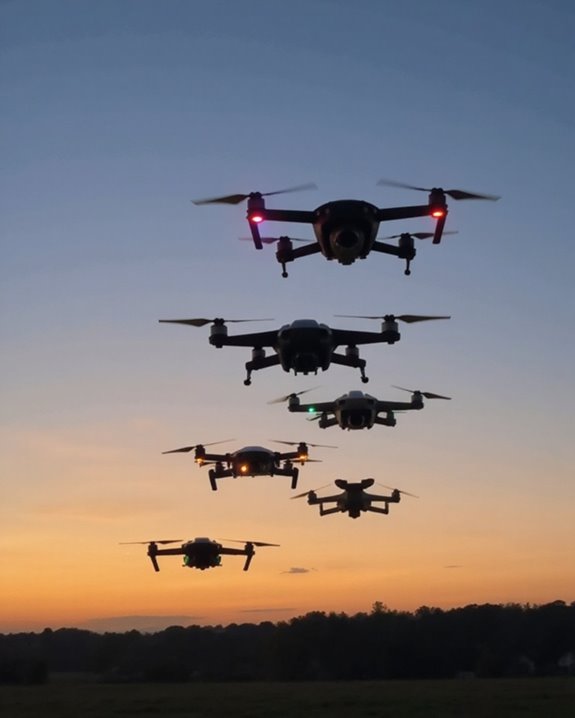
When you’re on the hunt for the world’s fastest drone, you’ll need to look beyond just the advertised top speed to make a smart choice! You’ll want to carefully weigh factors like flight time capacity (since higher speeds drain batteries faster), motor specifications, and the drone’s weight-to-power ratio, which all work together to determine real-world performance. While it’s tempting to focus solely on speed records, don’t forget to evaluate the drone’s wind resistance rating and overall size, as these elements can make the difference between a lightning-fast champion and an expensive paperweight when conditions aren’t perfect.
Maximum Speed Capabilities
Understanding a drone’s maximum speed capabilities can make the difference between capturing that perfect aerial shot and watching your subject disappear into the distance! You’ll find that today’s high-performance drones can reach impressive speeds up to 58 kph in sport modes, which is perfect for those action-packed aerial pursuits.
In windless conditions, you’re looking at consistent speeds around 22 kph, but don’t worry if it gets breezy! Many modern drones can maintain an impressive 38 kph even in level-5 winds – talk about fighting against the elements! Your speed potential largely depends on flight modes and motor types, with brushless motors pushing speeds up to 16 m/s in specialized settings. Just remember, while standard modes keep things steady, switching to high-speed mode can unleash those thrilling 50+ kph velocities!
Flight Time Versus Speed
Although reaching top speeds with your drone can be exhilarating, you’ll need to carefully consider the trade-off between velocity and flight time! When you push your drone to its limits, you’re actually cutting its flight duration substantially – sometimes by half when exceeding speeds of 16 meters per second.
Think of it like a sports car: the faster you go, the more fuel you burn! Your drone’s battery capacity plays a vital role, and those pesky headwinds won’t do you any favors either. While larger batteries might seem like an obvious solution, they’ll add weight that could slow down your speed demon.
Most high-performance drones nowadays give you between 30 to 90 minutes of flight time, depending on how fast you’re pushing them. It’s all about finding that sweet spot between speed and endurance!
Motor Type and Power
The heart of any speed demon drone lies in its motor system! When you’re chasing those blistering speeds above 50 km/h, you’ll need high-quality brushless motors that can handle the heat while delivering maximum thrust. These powerhouses aren’t just about raw strength – they’re efficiency masters that’ll keep your drone zooming without burning through batteries.
You’ll want to look for a motor-to-weight ratio exceeding 2:1, which is like giving your drone superhuman muscles! The more powerful your motors, the better you’ll slice through those pesky headwinds at speeds up to 40 km/h. And here’s the real kicker: proper motor selection guarantees your speed machine won’t turn into a melting mess at 20+ meters per second. Remember, in the world of high-performance drones, your motors are literally where the rubber meets the sky!
Weight and Size Impact
When it comes to blazing speeds, size and weight make all the difference in your drone’s performance! Think of it like a sports car – the lighter and more streamlined your drone is, the faster it’ll zip through the air. You’ll want to keep an eye out for those nimble sub-249-gram models that can really show off their speed potential.
The physics is simple: smaller drones face less air resistance, and lighter ones don’t have to work as hard to maintain those thrilling high speeds. If you’re chasing velocity records, you’ll love how compact drones can slice through the air like butter! Plus, with less weight to carry around, your drone’s motors can focus their power on pure speed rather than just staying airborne. It’s no wonder the speediest drones often come in smaller, lighter packages!
Wind Resistance Rating
Understanding wind resistance ratings proves essential for speed demons looking to push their drones to the limit! You’ll want to pay close attention to those Beaufort scale numbers, as they’re your ticket to maintaining control when you’re zooming through the skies.
When you’re chasing top speeds, you’ll need a drone that can handle winds of at least 38 kph (Level 5), or you might find your speedster performing an unplanned acrobatic show! The higher the rating, the better your drone will maintain its trajectory and speed without getting knocked off course. Look for models sporting robust motors and sleek aerodynamics that can tackle those 40 kph gusts – they’re worth every penny when you’re pushing for maximum velocity. Trust us, there’s nothing worse than watching your speed run get derailed by an unexpected breeze!
Transmission Range Limits
How far can you push your need for speed before losing that crucial connection to your lightning-fast drone? You’ll want to keep those transmission limits in mind before your speedy companion turns into an expensive runaway!
Most aviation authorities cap transmission ranges at 10 kilometers, but don’t get too excited – real-world conditions often cut that distance in half. You’re looking at effective ranges between 4-6 kilometers in urban areas, where buildings and obstacles love to play interference games with your signal. Weather conditions can be quite the party pooper too!
When you’re choosing your speed demon, pay attention to those frequency bands and power outputs. Higher frequencies might sound impressive, but they’ll limit your range greatly. Remember, even the fastest drone isn’t much fun if you can’t keep it connected!
Frequently Asked Questions
How Much Training Is Required Before Flying High-Speed Drones?
Just like you wouldn’t jump into an F1 race car without training, you’ll need solid preparation before piloting high-speed drones! Start with 20-30 hours of practice on beginner drones to master the basics. You’ll then need specialized training courses (typically 15-20 hours) focused on high-speed operations, safety protocols, and advanced maneuvers. Don’t forget to check your local regulations – many areas require certification for racing drones that exceed certain speeds.
Are There Special Licenses Needed for Racing Drones?
Yes, you’ll need specific licenses depending on where you’re racing! For recreational drone racing in the US, you must obtain your TRUST certificate from the FAA – it’s free and easy to get online. If you’re planning to compete professionally or fly drones over 250g, you’ll also need a Part 107 certification. Don’t forget to check local regulations too, as some racing venues require additional permits or memberships.
What Safety Features Prevent Fast Drones From Crashing?
Racing drones come equipped with several key safety features to keep you flying smoothly! You’ll find failsafe systems that automatically trigger a controlled landing if signal’s lost, and sturdy carbon fiber frames that absorb impacts. There’s also return-to-home GPS functionality, obstacle avoidance sensors, and adjustable power limitations. Plus, you’ll love the protective propeller guards – they’re like guardrails for your drone, keeping both your investment and nearby objects safe during those adrenaline-pumping flights!
Do Weather Conditions Affect Maximum Drone Speeds?
Yes, weather conditions dramatically affect your drone’s top speed! Wind resistance is your biggest challenge – headwinds can greatly slow you down, while tailwinds might give you a boost. You’ll also need to watch out for rain, snow, and high humidity which can damage your drone’s electronics and reduce performance. Temperature matters too – extreme heat or cold affects battery efficiency and motor output. For best results, you’ll want clear skies with minimal wind!
Can Racing Drones Carry Cameras Without Compromising Their Speed?
You bet racing drones can carry cameras – but here’s the exciting catch! While most racing drones come equipped with tiny FPV (First Person View) cameras, they’re specifically designed to be ultra-lightweight. You’ll find these specialized cameras weigh just a few grams and are streamlined to minimize drag. Unlike bulky action cameras that could slow you down, these sleek FPV systems let you experience the thrill of high-speed flight without compromising your drone’s performance!

